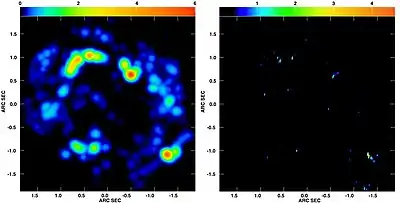European VLBI Network
The European VLBI Network (EVN) is a network of radio telescopes located primarily in Europe and Asia, with additional antennas in South Africa and Puerto Rico, which performs very high angular resolution observations of cosmic radio sources using very-long-baseline interferometry (VLBI). The EVN is the most sensitive VLBI array in the world, and the only one capable of real-time observations. The Joint Institute for VLBI ERIC (JIVE) acts as the central organisation in the EVN, providing both scientific user support and a correlator facility. Very Long Baseline Interferometry (VLBI) achieves ultra-high angular resolution and is a multi-disciplinary technique used in astronomy, geodesy and astrometry.
 The first e-VLBI science image produced by the European VLBI Network | |
| Alternative names | EVN |
|---|---|
| Website | www |
| Telescopes |
|
| | |
The EVN operates an open-sky policy, allowing anyone to propose an observation using the network[1]
EVN Telescopes
The EVN network comprises 22 telescope facilities:[2]
Additionally the EVN often links with the UK-based 7-element Jodrell Bank MERLIN interferometer. It can also be connected to the US Very Long Baseline Array (VLBA), achieving a global VLBI, obtaining sub-milliarcsecond resolution at frequencies higher than 5 GHz.[3]
e-EVN
Since 2004, the EVN has started to be linked together using international fibre optic networks, through a technique known as e-VLBI. The EXPReS project was designed to connect telescopes at Gigabit per second links via their National Research Networks and the Pan-European research network GÉANT2, and make the first astronomical experiments using this new technique. This allows researchers to take advantage of the e-EVN's Targets of Opportunity for conducting follow-on observations of transient events such as X-ray binary flares, supernova explosions and gamma-ray bursts.
EXPReS's objectives are to connect up to 16 of the world's most sensitive radio telescopes on six continents to the central data processor of the European VLBI Network at the Joint Institute for VLBI ERIC (JIVE). Specific activities involve securing "last-mile connections" and upgrading existing connections to the telescopes, updating the correlator to process up to 16 data streams at 1 Gbit/s each in real time and research possibilities for distributed computing to replace the centralized data processor.
History
The EVN was formed in 1980 by a consortium of five of the major radio astronomy institutes in Europe (the European Consortium for VLBI). Since 1980, the EVN and the Consortium has grown to include many institutes with numerous radio telescopes in several western European countries as well as associated institutes with telescopes in Russia, Ukraine, China and South Africa. Proposals for an additional telescope in Spain are under consideration.
Observations using the EVN have contributed to scientific research on Fast Radio Bursts (FRBs),[4] gravitational lensing,[5] and supermassive black holes.[6]
See also
References
- "Using the EVN | EVLBI". www.evlbi.org. Retrieved 2020-02-07.
- "Pictures of EVN telescopes". Archived from the original on 2012-02-24. Retrieved 2018-09-26.
- "Introduction to the EVN". Archived from the original on 2012-02-24. Retrieved 2014-02-03.
- "A repeating Fast Radio Burst from a spiral galaxy deepens the mystery of where these signals originate from | Jive". www.jive.eu. Retrieved 2020-02-07.
- "New images from a super-telescope bring astronomers a step closer to understanding dark matter | Jive". www.jive.eu. Retrieved 2020-02-07.
- "Surprise discovery provides new insights into stellar deaths | Jive". www.jive.eu. Retrieved 2020-02-07.
External links
 Media related to European VLBI Network at Wikimedia Commons
Media related to European VLBI Network at Wikimedia Commons- The European VLBI Network on the internet
- Joint Institute for VLBI ERIC on the internet